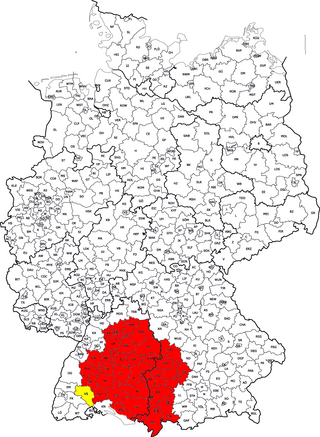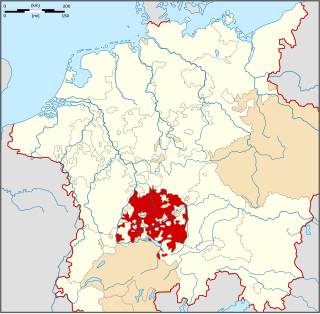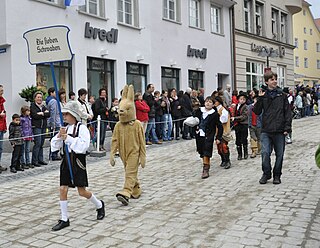
The Alemanni or Alamanni were a confederation of Germanic tribes on the Upper Rhine River during the first millennium. First mentioned by Cassius Dio in the context of the campaign of Roman emperor Caracalla of 213, the Alemanni captured the Agri Decumates in 260, and later expanded into present-day Alsace and northern Switzerland, leading to the establishment of the Old High German language in those regions, which by the eighth century were collectively referred to as Alamannia.
Capital and its variations may refer to:

The Hohenstaufen dynasty, also known as the Staufer, was a noble family of unclear origin that rose to rule the Duchy of Swabia from 1079, and to royal rule in the Holy Roman Empire during the Middle Ages from 1138 until 1254. The dynasty's most prominent rulers – Frederick I (1155), Henry VI (1191) and Frederick II (1220) – ascended the imperial throne and also reigned over Italy and Burgundy. The non-contemporary name of 'Hohenstaufen' is derived from the family's Hohenstaufen Castle on Hohenstaufen mountain at the northern fringes of the Swabian Jura, near the town of Göppingen. Under Hohenstaufen rule, the Holy Roman Empire reached its greatest territorial extent from 1155 to 1268.

The Suebi were a large group of Germanic peoples originally from the Elbe river region in what is now Germany and the Czech Republic. In the early Roman era they included many peoples with their own names such as the Marcomanni, Quadi, Hermunduri, Semnones, and Lombards. New groupings formed later, such as the Alamanni and Bavarians, and two kingdoms in the Migration Period were simply referred to as Suebian.

Swabia is one of the seven administrative regions of Bavaria, Germany. It consists of ten districts and 340 municipalities with Augsburg being the administrative capital. It is the only German region officially named Swabia in the principle of spatiality.
Swabian or Schwabian, or variation, may refer to:

Swabia is a cultural, historic and linguistic region in southwestern Germany. The name is ultimately derived from the medieval Duchy of Swabia, one of the German stem duchies, representing the historic settlement area of the Germanic tribe alliances named Alemanni and Suebi.

Alamannia, or Alemania, was the kingdom established and inhabited by the Alemanni, a Germanic tribal confederation that had broken through the Roman limes in 213.

A stem duchy was a constituent duchy of the Kingdom of Germany at the time of the extinction of the Carolingian dynasty and through the transitional period leading to the formation of the Ottonian Empire. The Carolingians had dissolved the original tribal duchies of the Empire in the 8th century. As the Carolingian Empire declined, the old tribal areas assumed new identities. The five stem duchies were Bavaria, Franconia, Lotharingia (Lorraine), Saxony and Swabia (Alemannia). The Salian emperors retained the stem duchies as the major divisions of Germany, but the stem duchies became increasingly obsolete during the early high-medieval period under the Hohenstaufen, and Frederick Barbarossa finally abolished them in 1180 in favour of more numerous territorial duchies.

The Circle of Swabia or Swabian Circle was an Imperial Circle of the Holy Roman Empire established in 1500 on the territory of the former German stem-duchy of Swabia. However, it did not include the Habsburg home territories of Swabian Austria, the member states of the Swiss Confederacy nor the lands of the Alsace region west of the Rhine, which belonged to the Upper Rhenish Circle. The Swabian League of 1488, a predecessor organization, disbanded in the course of the Protestant Reformation and the Thirty Years War later in the 16th century.

The Duchy of Swabia was one of the five stem duchies of the medieval German Kingdom. It arose in the 10th century in the southwestern area that had been settled by Alemanni tribes in Late Antiquity.

Swabians are a Germanic-speaking people who are native to the ethnocultural and linguistic region of Swabia, which is now mostly divided between the modern states of Baden-Württemberg and Bavaria, in southwestern Germany.
Several leagues of cities became influential in the history of the Holy Roman Empire. Military alliance and mutual assistance strengthened the position of imperial cities, especially during the interregnum period of the 13th to 14th century.

Upper Swabia is a region in Germany in the federal states of Baden-Württemberg and Bavaria. The name refers to the area between the Swabian Jura, Lake Constance and the Lech. Its counterpart is Lower Swabia (Niederschwaben), the region around Heilbronn.
Banat is a geographical and historical region of southeastern Europe.
Ländle is sometimes used in German as a colloquial sobriquet for any of the following territories:

The Schwabengau was an early medieval shire (Gau) in the Eastphalia region of the medieval Duchy of Saxony. Ruled by the House of Ascania, it became the nucleus of the later Principality of Anhalt, today part of the German state of Saxony-Anhalt.
This page is based on this
Wikipedia article Text is available under the
CC BY-SA 4.0 license; additional terms may apply.
Images, videos and audio are available under their respective licenses.











